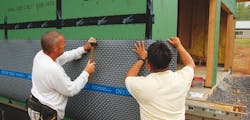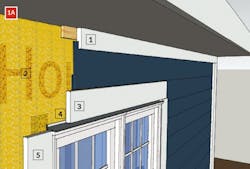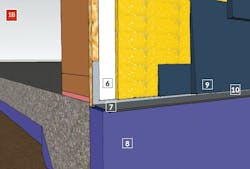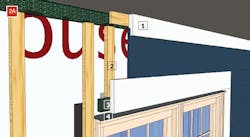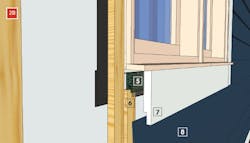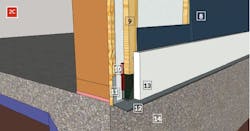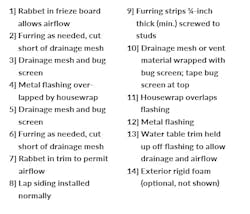Building Things Right: Rainscreen Siding Systems
Delta-Dry is an HDPE roll material at the core of Cosella-Dörken’s Delta Rainscreen System. The dimpled surface promotes drainage and airflow at both sheathing and siding. Compatible bug screen and flexible sealing tape are also available.
All illustrations: Dan Morrison; photo: courtesy Cosella-Dörken
The wall is perhaps the most misunderstood and poorly devised assembly in the modern built environment. Walls today have six to 10 layers of materials, each with significantly different properties and little source uniformity. I still routinely hear otherwise intelligent people talking about letting the walls breathe, demonstrating the chasm that exists in our industry about how walls work. Letting your walls breathe is a terrible idea. But letting your cladding breathe is an awesome idea!
A Forgiving Assembly
Houses inevitably get wet, and in a variety of ways. Liquid water (called “bulk” water) from rain, sprinklers, leaky pipes, floods, etc., will find a way past the flashing tape and the perfectly caulked siding and into the cable guy’s holes. Water vapor will get past the perfect vapor retarder and impeccable air barrier.
And that’s OK—wood can get wet, but it also needs to dry. In fact, most building materials can take a little moisture, but they all need to be able to dry.
When you insulate, you reduce the drying potential of the wall assembly. No way around it. In a heating climate, insulation lowers the temperature inside the wall by reducing the energy inputs, and that reduces the capacity for the air to hold moisture, which forces it to condense, thereby further reducing drying potential. If you turned the thermostat up and got rid of the insulation—essentially the way “breathing” houses used to operate—you would burn a lot of fuel, but your walls would be warm and dry.
That isn’t going to happen these days, so let’s talk about wall assembly solutions, starting with the cladding. (We’ll talk about insulation next time.)
A Breath of Fresh Air
The easiest way to ensure that a home sheds water effectively and dries efficiently is by installing a ventilated rainscreen under the cladding material. Simply put, this is a continuous layer of air behind the cladding that is connected to outside air at the top and bottom.
Good
One solution is to use a housewrap such as HydroGap from Benjamin Obdyke, which uses small spacers to hold the siding away from the main drainage plane, or Tyvek DrainWrap from DuPont, which uses shallow channels to create better drainage. These products are relatively inexpensive and install just like ordinary housewrap.
Better
A better system is one that is vented at the top of the wall and at the bottom. You can achieve this with products such as Slicker Classic Rainscreen 6 mm, a dense woven mat from Benjamin Obdyke that you can nail through and which provides multidirectional venting without changing anything else [1A & 1B]. You can use it with or without exterior foam, and you don’t need to add any additional blocking. It’s easy to install and works great. If there is one detail I’d like to see on every project, it’s this one.
Another option is to install the cladding over furring strips [2A, 2B, & 2C]. For lap siding, applying vertical Cor-A-Vent Sturdi-Strips, or just strips of untreated solid wood or plywood, over a WRB (weather-resistant barrier) creates air channels that are vented top and bottom. The air space should be a minimum of ¼ inch, although ⅜ inch or larger is more common.
However, you must provide an outlet or inlet above and below every horizontal wall element—typically, window sills, and door and window head casings—to maintain the flow of air that is essential for rapid drying. In my experience, it’s worth using Cor-A-Vent accessories at those locations (but make sure the painter doesn’t caulk them all shut). According to the manufacturer, Cor-A-Vent SV-3 Siding Vents, which are 3 inches wide and 7/16-inch thick, will work with the ⅜-inch-think Sturdi-Strips or other furring material up to ½-inch thick; and SV-5 Siding Vent strips, which are 3 inches wide and ¾-inch thick, will match up with 1-by furring.
Furring strips are often used over exterior rigid foam insulation, where they serve double-duty holding the foam in place. But it’s a more complicated system than the mesh system and is therefore more likely to be installed incorrectly. If you use furring, be careful not to block the airflow at the top or bottom of the wall and around any penetrations; otherwise you’ll defeat the whole purpose of the rainscreen.
Best
The best solutions employ products such as Cosella-Dörken’s Delta-Dry (lead photo, above), a flexible dimpled sheet that creates two independent airflow paths—one on the sheathing/WRB side of the assembly and one on the cladding side. This keeps interior and exterior air streams from cross-contaminating. This material is expensive and it can be a bit difficult to install, especially on older homes where the framing has sagged or twisted. But it’s the bomb.
---
Michael Anschel is president of Otogawa-Anschel Design+Build, in Minneapolis, and a founding board member of Greenstar.
